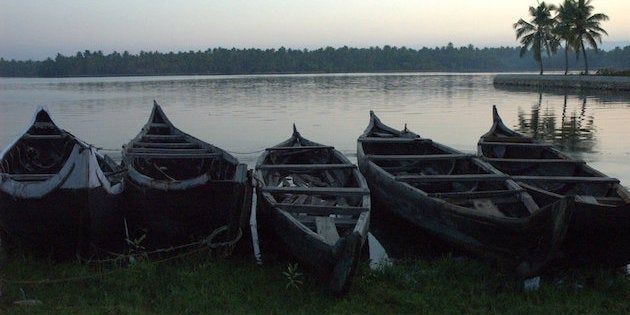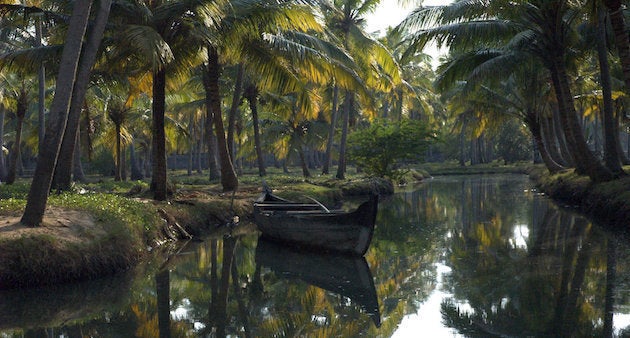

By Ajith Lawrence*, MM Paniyil*, Thiruvananthapuram, Kerala
Pre-monsoon showers are already on and the monsoon is expected to hit Kerala two days ahead of schedule this time. Kerala is mainland India's doorstep for the monsoons which make landfall there with clockwork precision on 1 June usually. Now that the rains are here, Kerala has a chance to catch it where it falls, and a policy push to this effect has come from none other than the state's chief minister Pinarai Vijayan, who is not known for his green sentiments. Extraordinary times in Kerala require extraordinary measures.
This tropical state, lying between 8°18' and 12°48' North latitudes, receives annual average rain of 3,107 mm — enough to sustain the rain forests that the state is home to. Even Kerala's dryer parts get 1,500 mm rain, which is more than India's average. The monsoon rains are spread over 120 to 150 days in two stretches.
The state is usually so wet that people fetch drinking water from open backyard wells, temple ponds are always full, and you can travel from south to north along waterways, almost uninterruptedly.
The state is usually so wet that people fetch drinking water from open backyard wells two to ten metres deep. Temple ponds are always full and deep. You can travel from south to north along waterways, almost uninterruptedly. The concern is that all this is going to vanish at some point. Scientists have already painted a grim picture of Kerala going dry in the coming years thanks to the changing climate, growing cities and vanishing forests and farmlands. They say that omens are already visible.
Serious crop losses
During the drought, Kerala's farmers have suffered serious crop losses and even wetland ecosystems that ensured bumper crops have turned saline and barren with no freshwater inputs. Ornithologists have reported dry land birds flocking to dry lakebeds, and foresters feared that wild animals would enter villages in search of water, while dry grass and bamboo pose the risk of wildfires.
A "grave situation" is how revenue minister E. Chandrasekharan described it in his budget speech in March. Over half of the reservoirs have dried up and he had to disburse ₹295 million to districts to tackle the drinking water shortage. Last year the southwestern monsoon rainfall during June - September period was short by about a third; and the northeastern monsoon came late with an even bigger deficit.
During the drought, Kerala's farmers have suffered serious crop losses and even wetland ecosystems that ensured bumper crops have turned saline and barren with no freshwater inputs.
Managing water
Vijayan has urged local bodies to use Mahatma Gandhi National Rural Employment Guarantee scheme, which ensures 100 days of work to every poor rural household, to build check dams and clean canals and ponds. The Centre has declared Kerala as drought-hit and increased funding for the scheme. Vijayan has welcomed schools, colleges, local self-help groups called Kudumbashree and local governance institutions to contribute to conserve water in the state's countless ponds and wells, and save rivers, canals and lagoons that run along and across the whole state.
The chief minister's green mission, known as Haritha Keralam, aims at conserving, cleaning and clearing these water bodies. "The success of Haritha Keralam mission will depend on how far it reaches out to the people," Vijayan said in a media statement.
At the local level, with Kerala's vibrant Panchayati Raj system, the government has urged local institutions as well as 200,000 volunteers of Kudumbashree to chip in to the effort. Kudumbashree is the women empowerment and poverty eradication program, framed and enforced by the State Poverty Eradication Mission (SPEM) of the Government of Kerala.
Besides industry-scale extraction, destruction of the Western Ghats ecosystem and deforestation, bad building practices are also contributing to a trend of water shortage.
State subsidies
The local bodies are promoting rainwater harvesting in houses, with the state government providing subsidies to install rooftop water harvesting systems. A new technology being introduced is an in situ filtre that cleans up the water at the collection points so that it flows straight and clean into the wells.
The state's low-cost housing lobby, comprising architects, environmentalists and planners, has been promoting water conservation at the household level. At a recent fair in the state capital, Thiruvananthapuram, they demonstrated harvesting and filtering techniques, and pushed it as a solution to falling groundwater levels. As per the 2001 Census, 72 percent of the households used water from open wells, but their numbers had reduced to 62 percent by 2011.
As for civil society efforts, Mazhapolima (Bounty of Rain), an NGO based in the central district of Thrissur, has floated a participatory effort for groundwater recharge using shallow dug wells. After its success in Thiruvilwamala, the birthplace of the iconic Malayalam writer Vadakke Koottala Narayanankutty Nair, the technique is now catching up elsewhere as well.
Reining in water extraction
Besides promoting such efforts, the government is considering putting controls on ground water extraction, as minister Chandrasekharan stated in his budget speech. Besides industry-scale extraction, destruction of the Western Ghats ecosystem and deforestation, bad building practices are also contributing to a trend of water shortage, according to some green architects.
Sloped roofs that are exceptionally good at directing water from the surface into the guttering and to collection points gave way to concrete flat roofs during the construction boom of the 1970s and 1980s. The concrete flat roofs are inefficient in terms of insulation from heat and directing water. There has been a very slow reverse trend of late.
In northern Kerala, at the southern tip of the Deccan plateau on the Western Ghat slopes, 200 waterholes in three forest ranges of Wayanad district have dried up, forest officials reported.
Another trend that prevents water seepage into the well is the practice of paving or plastering the space around houses, leading to flush drainage of water in a matter of minutes. Exposed loose sand, soil or lawn would aid seepage of rainwater into the ground contributing to wells and ground water aquifers.
"Even though the state gets 3,000 mm of rains on an average in a year, accelerated run off to the sea leaves very little water behind," said a Mazhapolima spokesperson. Architect G. Shankar, a Padmasree award winner who heads the Habitat Technology Group in Thiruvananthapuram, said that much of the prevalent building practices go against the housing ethos of the state and the environment. "We need a sustainable construction policy for urbanization," Shankar told VillageSquare.in.
Drying forests
Not only have Kerala's farmlands, villages and cities been affected by the drought, the state's forests and waterholes have also been drying up, potentially driving animals to villages in search of water and dried grass and bamboo. There threat of wildfires, rare in Kerala, will also go up.
In northern Kerala, at the southern tip of the Deccan plateau on the Western Ghat slopes, 200 waterholes in three forest ranges of Wayanad district have dried up, forest officials reported. In Muthanga range, there are 60 water holes, in Bathery, a 100, and in Hurichiyat, 40, from which around 400 elephants, 60 tigers and hundreds of bison, bears, deers and monkeys drink. "Rainfall in Wayanad has gone down by 45 percent," Wayanad wildlife warden, P. Dhanesh Kumar told VillageSquare.in.
Many rocky structures along the Western Ghats foothills are being flattened by quarry operations, thereby killing springs close to their origins. A lack of green cover on hill slopes increases water runoff, decreasing recharge of springs. And, a reduction in canopy also reduces soil moisture.
That means the local forest streams have dried up. "Though all the streams connecting Noolpuzha have dried up, we have certain quantity of reserve water in two dams. We have taken steps to fill the water holes, taking water in tankers," Sajeev M P Kurichiyat, deputy range officer, said.
Forest officials said that the Kabani River, one of the rare east flowing rivers in the state, with its two tributaries Panamaram and Mananthavady, was helping them tide over the water crisis. In Muthanga, range officer S Heeralal and colleagues were planning to build earthen bunds (embankments) and tarpaulin-lined artificial ponds to store water.
Three reasons
Environmentalists have pointed to three reasons behind the water crisis in the forests. Many rocky structures along the Western Ghats foothills are being flattened by quarry operations, thereby killing springs close to their origins. A lack of green cover on hill slopes increases water runoff, decreasing recharge of springs. And, a reduction in canopy also reduces soil moisture.
Environmentalists and local officials have been lobbying to put a stop to rampant deforestation and construction in an around Wayanad. A recent drive to demolish illegal constructions in the region was met with protests from migrant farmers, and political and religious groups that patronise them, to the point that the whole operation had to be slowed down.
Environmentalists and local officials have been lobbying to put a stop to rampant deforestation and construction in an around Wayanad.
In Kerala, which calls itself God's Own Country, drought is a not just a climate and weather-related phenomenon. At the same time, Keralans are also historically known for collective social action to save their environment, as displayed by protests scrapping the Silent Valley dam project in the 1980s.
Ajith Lawrence is a journalist and community broadcaster based in Thiruvananthapuram. MM Paniyil researches and writes on environmental issues, and is based in Bengaluru.
This article was first published on VillageSquare.in, a public-interest communications platform focused on rural India.